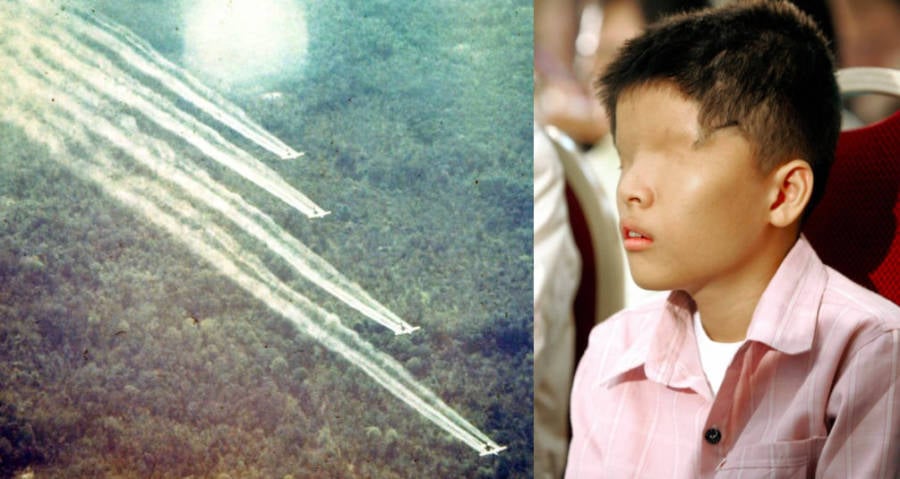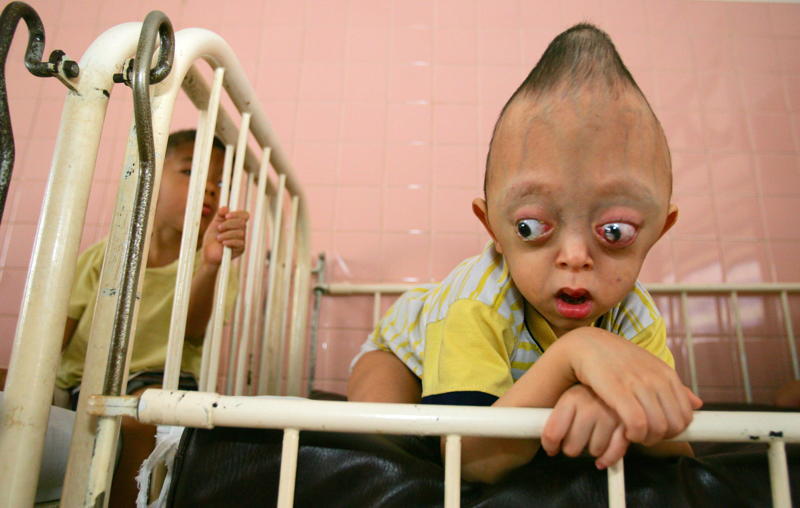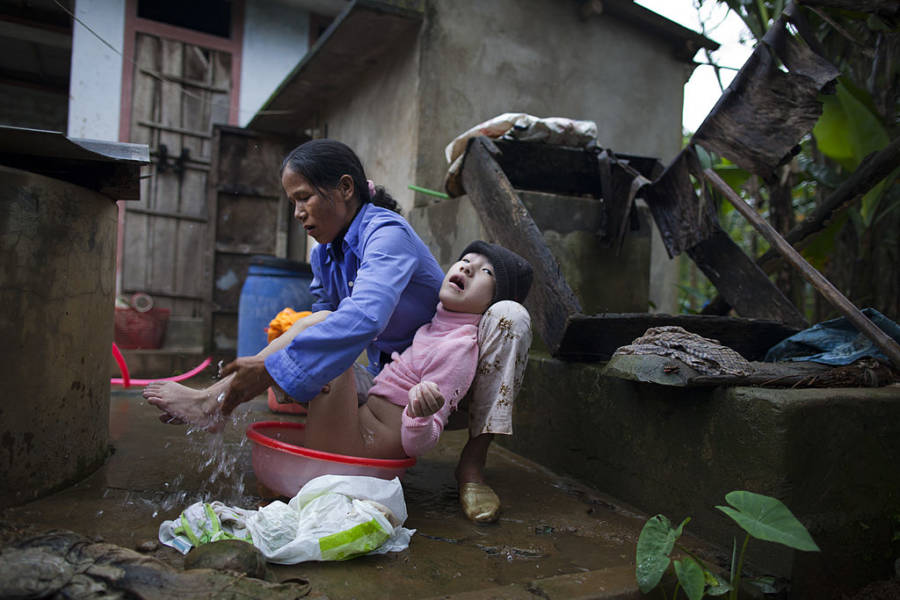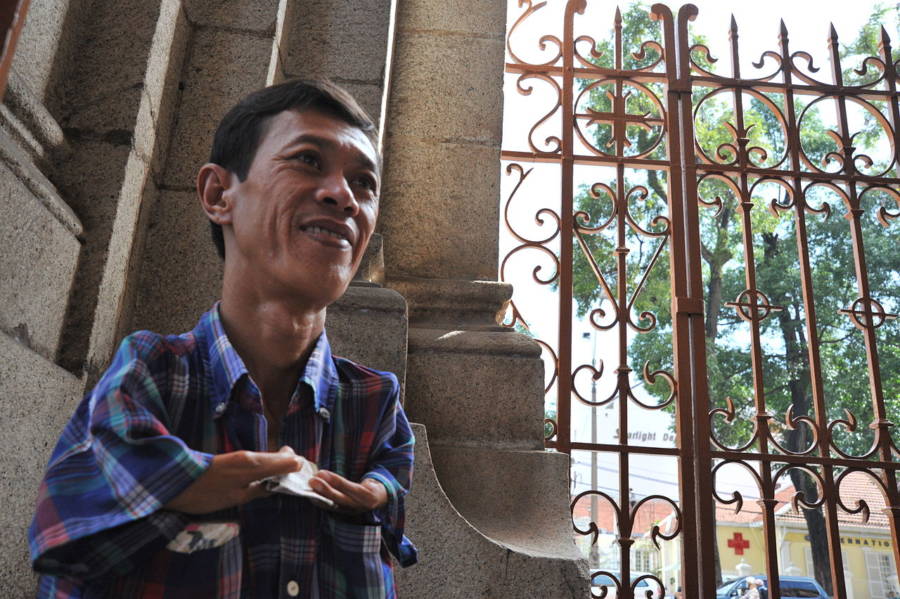The toxic chemical wreaked havoc on the people of Vietnam during the Vietnam War and had debilitating side effects that many continue to feel today.

(Left): Wikimedia Commons, (Right): Hoang Dinh Nam/AFP/Getty Images(Left): Three planes fly over Vietnam releasing Agent Orange circa 1961-1971., (Right): Le Van O., a 14-year-old boy who was born without eyes because of the effects of Agent Orange.
For the 40 years following the end of the Vietnam War the U.S. corporation, Monsanto, has largely evaded responsibility for their role in a chemical attack which had disastrous effects on Vietnamese civilians. But now the Vietnamese government demands that Monsanto pay compensation to the victims of Agent Orange.
Agent Orange is a toxic chemical that Monsanto had helped manufacture for the U.S. military during the Vietnam War, and is reportedly responsible for the birth defects and diseases of many of the country’s citizens. This will be the third generation of Vietnamese seeing effects of the chemical.

Business InsiderA Vietnamese child who has suffered birth defects likely caused by Agent Orange.
During the height of the Vietnam War, the U.S. and South Vietnamese air forces sprayed the toxic chemical from planes and helicopters onto their enemy below. The original plan was to poison the Viet Cong’s crops and wipe out entire forests, leaving the Viet Cong exposed and hungry.
This plan worked, but at an extreme cost. Between 1961 and 1971 the chemical, which was made 13 times stronger than its usual strength by the U.S. forces, destroyed millions of acres of farmland and forests. While it was supposed to destroy only those farms used to feed the Viet Cong’s army, it also mostly killed off the food sources for countless innocent civilians, leaving them to starve.
In addition to starvation, Agent Orange caused an array of health problems for the nearly four million people who were exposed to the chemical. According to the producers of the weapon, it was supposed to only harm plants not people, but that was not the case.

Paula Bronstein/Getty ImagesTran Thi Nghien bathes her handicapped daughter, an Agent Orange victim who is incapable of bathing herself.
Cam Lo, Vietnam. March 8, 2011.
Following this chemical warfare, babies across Vietnam were born with horrible mutations – some with physical and mental defects, others with extra fingers and limbs, and some without eyes.
Vietnam’s recent demand would require Monsanto to compensate many of the victims who were born with mental and physical problems the horrific weapon caused.
According to the Independent, Vietnam’s decision to demand compensation comes as a response to Monsanto’s being ordered to pay $289 million to DeWayne Johnson, a man who claims that the company’s Roundup weedkiller contributed to his terminal cancer.
Vietnam’s Foreign Ministry spokesperson, Nguyen Phuong Tra, spoke out after the landmark ruling last week and related the case to the damage Monsanto caused their citizens during the war.
“This case is a precedent that dismisses previous agreements that the herbicides supplied to the U.S. Military by Monsanto and other American chemical companies during the Vietnam War are not harmful to people’s health,” Tra said according to VN Express.
“We believe Monsanto should be held responsible for compensating Vietnamese victims of Agent Orange for the damage caused by the company’s herbicides,” Tra added.

Wikimedia CommonsProfessor Nguyen Thi Ngoc Phuong poses for a photo with the handicapped children under her care. Every one of them was born with a defect caused by Agent Orange. Ho Chi Minh City, Vietnam. December 2004.
This is not the first time that Vietnam has sought compensation in regards to the Agent Orange attacks.
According to VN Express, in 1984, Monsanto and several other American chemical companies reached a settlement which required them to pay $180 million to 291,000 people over 12 years.
Later in 2004, a class action lawsuit for brought against Monsanto and more than 30 other manufacturers of the chemical by the NGO Vietnamese Association of Victims in a New York court. The lawsuit was endorsed by the Vietnamese government.

Wikimedia CommonsA man begs for money outside of a cathedral. He was born with a deformed arm because of Agent Orange, and it makes it nearly impossible for him to find work. Ho Chi Minh City, Vietnam. June 1, 2009.
The Independent states that Monsanto has fought back against claims that they should accept responsibility for the Agent Orange attack, saying:
“The government set the specifications for making Agent Orange and determined when, where and how it was used. Agent Orange was produced for, and used by, the government.”
It’s been more than four decades since the U.S. first used the toxic chemical, but it seems that the debate over the monetary responsibility of Agent Orange is just getting started.
Next, check out these 33 declassified Vietnam War photos the public wasn’t meant to see. Then discover the Anti-Vietnam War movement in 39 photos.





